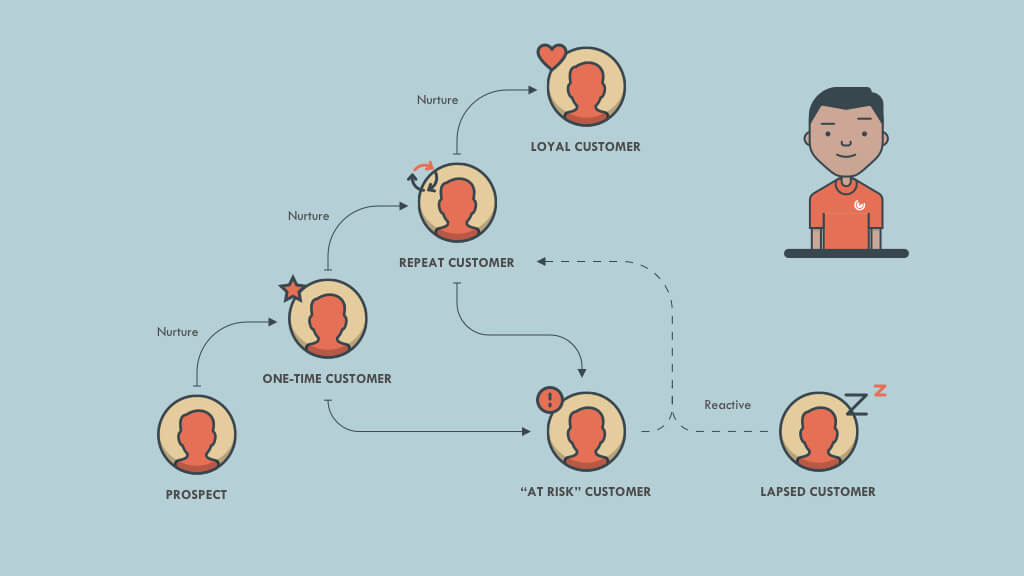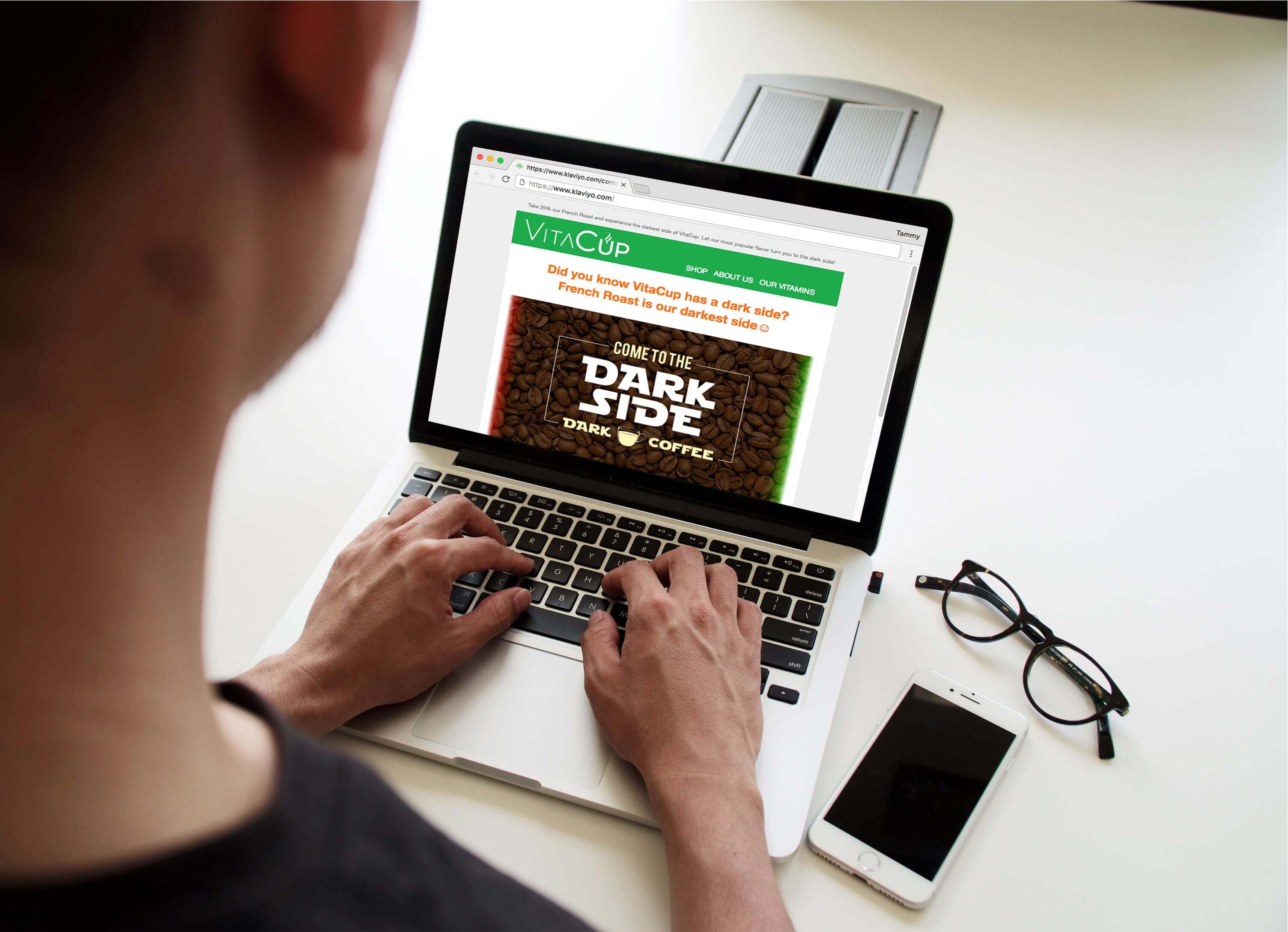Welcome back to the Lead Nurturing Masterclass! In this lesson, you will learn how to create a lead nurturing campaign for your eCommerce or B2C (business-to-customer) company where sales cycles are typically shorter, products are less complicated and you are catering to a single decision maker. But that doesn’t make B2C lead nurturing easier! You also have to deal with larger customer databases and behavior that can be more fickle, making for a highly hands-on approach after launch. Not to mention the fact that once a lead converts to a customer they are still a target for marketing—so your job never really ends!
The ECommerce and B2C Customer Lifecycle
Customer lifecycle is a term used to describe the progression of steps a customer goes through when considering, purchasing, using, and maintaining loyalty to a product or service. While there’s no single way to define a customer lifecycle for an eCommerce or B2C business, the following basic lifecycle is a good starting point for most:
- Prospects (aka Potential Buyers)
- First-time buyers (aka One-time Purchasers)
- Repeat Customers
- Loyal Customers
Now as mentioned, the moment a prospect becomes a customer, this does not mark the end of the relationship you, as a marketer, have with them. In fact, it is your job not only to motivate a prospect to make their first purchase but to manage the entire lifecycle turning them into repeat and loyal customers.
Why is it Important for You to Manage the Customer’s Lifecycle?
Simply put: You can’t build a sustainable eCommerce or B2C business without repeat customers. The primary reasons you need to focus on repeat business are:
- The cost to acquire a customer will continue to rise because there are limited customer acquisition channels.
- It is much easier (and cheaper) to convert and retain an existing customer than to acquire a new one.
- A loyal customer will not only purchase more, they will also spread the word for you and bring additional customers.
Core Elements of an ECommerce and B2C Lead Nurturing Campaign
Before we dive into any specific lead nurturing campaigns, let’s dive into the pieces you will need. As covered in Lesson 6, the core pieces for a building a lead nurturing campaign include:
- Hook
- Landing Pages
- Personalization and Segmentation
- Emails
- Workflows
- Nurture Content
- Reporting and Analytics
- Optimization
- Operator
- Automation Tools
Here, we will discuss how each element of a lead nurturing campaign can be designed for your eCommerce or B2C target audience.
Hook (aka Offer)
In the case of eCommerce, your hook is the promotional offer that captures a lead’s interest and their information in your form. This piece should provide value in a fairly straightforward way, as opposed to B2B hooks, which can often focus on education and provide value via information.
Examples of good B2C offers include:
- Percentage-based discounts
- Free shipping
- Buy-one-get-one free (BOGO)
- Quantity discounts
- Reward points
- Member savings
On the one hand, these are very straightforward offers so you can keep their design simple. On the other hand, you must make sure that the promotion is relevant and generous enough to fit your customers’ needs and wishes.
Landing Pages
Unlike traditional landing pages used in B2B, product pages and pop-ups are the main format taken by landing pages in B2C nurturing. Audiences have shorter interaction with these types of landing pages. Therefore, they should be designed with visually compelling elements, taking into consideration colors, images, spacing, and any other important branding elements. However, these all should be used with tact, not distracting the viewer from the offer, but rather complementing it.
The purpose of these landing pages should still be about conversion. That’s why a strong call-to-action (CTA) is crucial to getting leads to take your desired action—whether it's to join your mailing list or receive a discount code.
The desired action itself? Well, that depends on the landing page. Is it a product page? Then the desire action is a purchase. Is it a pop-up discounted offer? Then the goal is to capture their email. The nature of the offer is central to the landing page, but so is its presentation.
It’s a good idea to conduct search engine optimization on your eCommerce and B2C product pages so they can be found organically. Another tool to employ to optimize your landing page and pop-up conversion rates, which will be discussed later in-depth, is A/B testing.
Personalization and Segmentation
In eCommerce and B2C, customer databases are large and sales cycles are short. Entrepreneurs are taught to treat customers like the individuals they are. And when scaling from one to one hundred orders, that is somewhat manageable. But when brands begin servicing hundreds of customers at a time, it’s incredibly difficult to sustain highly personalized customer service and marketing efforts. The result—store owners start to take a blanket approach to promoting their products, with a universal message, targeting a single sort of consumer.
But, 74% of online consumers get frustrated with brands when content (e.g. offers, ads, and promotions) appear to have nothing to do with their interests. Today’s marketing content needs to adapt to individual customers’ precise interests. You can’t just send email blasts with one-size-fits-all messages. That’s why personalization and lead segmentation is crucial for setting your company apart from competitors.
In fact, according to the DMA, marketers have found a 760% increase in email revenue from segmented campaigns.
Segmentation gives marketers an efficient way to group customers by demographic information, purchase history, browsing activity, etc. so they can tailor email messages to specific groups.
Six broad customer segmentation criteria you can start with are:
- Demographics
- Customer lifetime value (LTV)
- Lifecycle stage
- Purchasing habits
- Multi-channel behavior and lead source
- Buyer personas and psychographics
Before you invest in nurturing a particular customer segment, Harvard Business Review editor Gretchen Gavett recommends that it meet the following criteria:
- The segment is identifiable. There are clear defining traits of your selected customer segment, and it is easy to measure their reactions to certain marketing campaigns and their purchasing behavior.
- The segment is substantial. It is expensive to market to each customer segment, so make sure any group you focus on has enough members who can drive meaningful revenue.
- The segment is accessible. There should be clear ways to communicate with these customers at scale, whether it is over email, SMS, or display advertising.
- The segment is stable. The definition for your customer segments should not change frequently.
- The customer segment is differentiable. Each of your customer segments should have distinct communication preferences and unique needs that they want stores to directly address. Marketers may want to consolidate groups that share the same communication preferences and needs.
- The customer segment is actionable. You should be able to design campaigns that actually mobilize these buyers to take action.
As mentioned, eCommerce and B2C leads continue to be targets for marketing even upon becoming a customer. So, one of the most common applications of customer segmentation for lead nurturing is with lifecycle marketing. We covered the basic lifecycle earlier but you can further divide repeat customers into 3 groups. Your lifecycle segments will look like this:
- All Customers - Start with your full customer list. From here, you can start creating custom segments.
- Potential Customers (a.k.a. Prospects) - These contacts have never purchased with you before, but have either submitted their email in exchange for a promotion, signed up for your email newsletter or created a shopping account and abandoned their cart.
- First-Time Buyers (a.k.a. One-time buyers) - These are customers who have only completed a single purchase with you.
- Repeat Customers - Customers who have made two or more separate purchases.
- Loyal Customers (a.k.a. Active Repeat Customers) - These customers have placed multiple orders in a short time frame. Calculate the average time each customer waits between purchases. Then, label the ones who complete repeat purchases within that timeframe as “active repeat customers.”
- At-Risk Repeat Customers - At-risk repeat customers made multiple purchases in the past but have let more time lapse since their last order than the average time all of your customers typically wait between orders.
- Inactive Repeat Customers (a.k.a. Idle, lapsed and latent customers) - These are customers who have placed multiple orders with you before but they have not placed another order for more than three times the average time customers spend between orders.
By segmenting your customers into smaller groups you are set up to provide them with specific, relevant lead nurturing campaigns.
Emails
The majority of your eCommerce or B2C campaign’s nurture content will be email.
Triggers for emails include customer behaviors or certain events, such as abandoning a cart, signing up for an email list, visiting a product page or making their first purchase. Your nurture email series must fit the unique needs of the customers while taking considerations specific to eCommerce into account, such as striking the right tone and scheduling for certain times of day.
While B2B emails tend to be more professional in manner and largely informative, B2C emails prioritize entertainment and aesthetics to a much greater degree. They also tend to be more design heavy and less personal.
We cover email in more detail below when we discuss MOFU/nurture content.
Workflows
ECommerce and B2C workflows are more typically more complex than in B2B, because the number of engagement channels are greater. These channels include, but aren’t limited to:
- Social
- SMS
- Messenger Apps
- Retargeting Ads (social and display)
With multi-channel engagement, an eCommerce or B2C brand is expected to reach customers over the channel of greatest convenience to the user. This means that a brand is expected to reach the customer at the channel that is most convenient to them at a given point in time. While email is a vital element of your nurturing strategy, it’s just one component of the workflows involved.
Though the topic will be covered more in-depth later, marketing automation allows marketers to connect all the dots of sending the right messages, content, and campaigns to customers at the right time and over the right channel. Furthermore, a system of alerts and rules based mainly around certain actions (or types of actions) customers take are responsible for triggering automated workflows.
Nurture Content
Each eCommerce or B2C lead nurturing campaign will be comprised of a series of messages—primarily delivered via email, but also through SMS, retargeting Ads, or Messenger. The nature of the campaign is determined by the goal for the campaign and the targeted lifecycle segment. The content contained within each message can then be personalized to account for the customer’s purchasing habits (i.e., what products they purchased and when) and their buyer personas.
Some lead nurturing campaigns are targeted at turning potential customers into customers such as promotional campaigns, unused offer campaigns, retargeting ad campaigns, and abandon cart campaigns. Let’s take the abandoned cart campaign as an example. This campaign is sent to potential customers who created a shopping account, but abandoned their cart. The goal of the nurturing series is for them to return to their cart and complete the purchase. As a general template:
- Email 1 reminds them of the particular items they left in their cart
- Email 2 provides them a small discount on the items in their cart
- Email 3 offers a slightly larger discount on the items in their cart
Other lead nurturing campaigns are targeted at customers and the content can take on several forms based on their behavior and lifecycle stage, such as:
- Order replenishment/repurchasing reminder
- Email newsletters with exclusive content, promotional campaigns, and discounts
- Post-purchase email series
- Up-sell/Cross-sell email
- Welcome or educational email series
- Anniversary emails
- Time-sensitive coupons
- Direct mail catalogs, coupons, or free product sample
- Free shipping offers
- Win-back campaigns
- “We miss you” prompts
- “How can we help?” questionnaires

In order to be most successful in motivating your target audience into action, refer back to your buyer personas and make sure your content:
- Speaks to their goals and pain points
- Expresses how your solution meets their goals or addresses their pain point
- Addresses objections they may have to your solution
In Step 3 of the next section, we cover in more detail how to choose the right campaign content based on your goal and targeted segment.
Reporting and Analytics
Nurturing revolves around gaining an understanding of the customer base, and analytical data is just the way to accomplish this. Analytics help in determining everything from the nature of future offers, to which customer segments they should reach, to the timing for the arrival of the offers.
“44% of B2C marketers leverage data analytics to boost their companies’ responsiveness.”
B2C reporting produces more instantaneous results than B2B, due to sales cycles being shorter and customer databases being larger. You don’t have to wait 3 months to see if an email you sent resulted in an increase in sales, you will know within a few hours of sending!
Optimization
With shorter sales cycles, B2C marketing is conducive to fast-paced data collection to gain insights into many optimization opportunities. The flip side of this is that constant optimization, particularly in the middle of the campaign funnel, is a virtual must.
Larger customer databases open the door for more complex testing and iterations. An example is multivariate testing, in which multiple variables are modified (as opposed to techniques like A/B testing, which focus on one at a time—though there is still room for them in a B2C campaign!).
The goal of multivariate testing is to determine which combination of variations produces the best possible results. On a product page, for instance, three variations of an image may be combined with two variations of a headline to create six versions of the content, which will be tested side-by-side. This type of test is only possible with the greater amount of traffic that eCommerce and B2C sites tend to see.
Operator
Your operator should primarily be an analyst, a data-driven marketer. Additionally, they need to be a master of the array of technological tools used to power and analyze your campaign. Ideally, they will have training in conversion rate optimization and experimentation.
Automation Tools
The tools required by an eCommerce or B2C company, of course, include a website (or eCommerce store) as well as email automation that integrates with the site. Everything from social media management to website maintenance to landing page optimization to analytics, will also require technological oversight.
General automation is very important so that each workflow in your campaign is connected and flawlessly targets multiple channels for best results. However, certain elements more specific to B2C also require attention, such as website pop-ups and your promotional SMS channel. A combination of tools (which there is luckily no shortage of!) will most likely need to be used in order to juggle a multi-channel campaign strategy.
In the case of eCommerce or B2C nurturing you want your core automation platform to include the following features:
- Comprehensive automated scheduling system
- Subject line and body personalization with contact information
- Custom email templates
- High capacity for running multiple kinds of campaigns simultaneously
- Email analytics
- A/B testing
- Advanced segmentation
- Revenue reporting
- Custom workflows
Additional features that are nice to have are:
- Product recommendation engines
- Single-use coupon capability
- On-site behavioral tracking
- Pop-ups
- SMS messages
- Visual workflows
- Purchase intent scoring
- Facebook advertising
- Email throttling
- Real-time tracking
How to Create an ECommerce and B2C Lead Nurturing Campaign in 5 Steps
The 5 Steps to Creating a Lead Nurturing Campaign:
- Define the goal of your campaign.
- Determine your target segment.
- Choose the right campaign for your goal and segment.
- Create content for your campaign.
- Tie it together with automation.
Step 1: How to Define the Goal for Your ECommerce and B2C Lead Nurturing Campaign
The primary goal for any business is to maximize profits. The best way to accomplish this goal is to not only increase your number of customers, but increase the lifetime value (LTV) of those customers.
Your lead nurturing campaign can contribute to the larger goal of increasing LTV by accomplishing one of the following specific goals:
- Move Potential Customers to First-Time Buyers
- Move First-Time Buyers to Repeat Customers
- Keep Repeat Customers active (i.e., turn Repeat Customers into Active Repeat Customers)
- Move At-Risk Customers back to Repeat Customers
- Win-back Idle Customers
Step 2: How to Determine Your ECommerce and B2C Target Audience
As seen, there are many ways to increase LTV. So when prioritizing which goal to pursue and which segment to target with your lead nurturing campaign, take into consideration two factors:
- The total opportunity associated with that segment
- How difficult or easy it may be to accomplish the goal for that segment (which is much more difficult to quantify, but should not be ignored)
To determine the opportunity associated with each segment, you want to quantify what you can gain if you meet each of the goals listed above. You can use a chart like the one below from Receiptful to estimate the size of the opportunity for each segment.
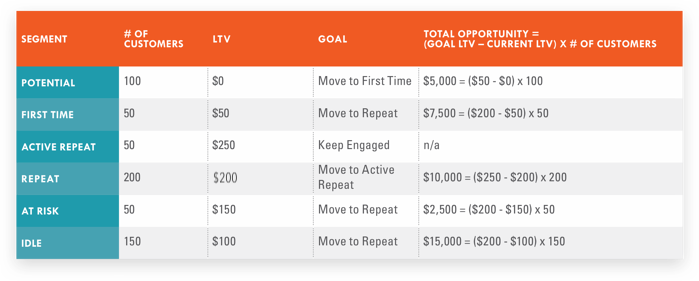
From our calculations in the example chart, it becomes immediately apparent that our largest opportunity is our Idle Customers.
Then you need to take into account the harder-to-quantify consideration, which is how easy or difficult it may be to accomplish your set-out goal for each particular segment. For instance, convincing idle customers to return and become repeat customers is likely a more resource-intensive project than simply engaging regular repeat customers and turning them into active repeat buyers.
Step 3: How to Choose the Right Lead Nurturing Campaign to Meet Your Goal.
Now that you have identified the biggest opportunity, it’s time to choose the right campaign to meet your goal. This can be somewhat formulaic. The chart below outlines the types of campaigns recommended to achieve the five goals outlined earlier.
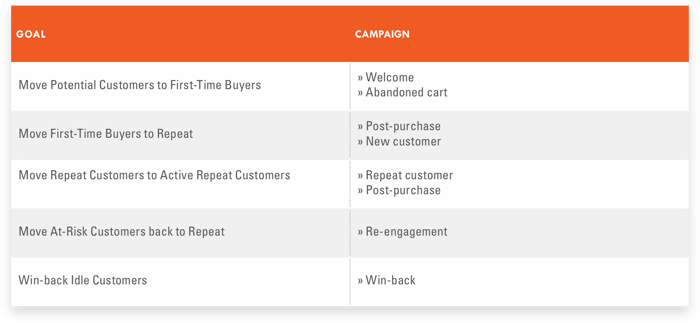
Step 4: Create Content for Your Lead Nurturing Campaign
Now that you have selected the right campaign for the job, let’s see what content should be included in each of these campaigns.
Abandoned Cart Campaign
Nearly 60-70% of online shopping carts are abandoned. Because most people tend to abandon carts due to price or readiness, discounts and consistent reminders have been proven to return leads to your site to complete their purchase.
“$260 billion in sales each year are lost due to abandoned carts” - Leverage Marketing
Regardless of the reason, the goal of your abandoned cart campaign is to get these shoppers to come back and complete their purchase. All emails should include the following elements:
- The abandoned item displayed as part of the message and subject line
- Product image
- A backlink URL directed to the abandoned-cart checkout
We recommend including the following three emails in your abandoned cart campaign:
Email 1: Cart Reminder
The first email in the campaign, sent one hour after abandon, should be a simple reminder to the customer that they left something in their cart. The message should have more of a customer-service oriented tone and can also include a modest discount.
Email 2: Cart Incentive
The second email is sent one day after abandon. You should present an offer (i.e., discount code or free shipping), but ensure it is slightly better promotional offer than email 1 if you did offer a promotion. Create urgency by giving them a short timeline to use the promotional discount—three days at the most. This email will encourage those buyers who were stuck on price or thinking about buying from a competitor to complete their purchase.
Email 3: Cart/Incentive Expiration
The third email in this series, sent 3 days after abandon, can be considered optional but should be included if you didn’t offer a discount in email 1 or prospects aren’t converting from either the first two emails. The messaging can be around the cart and/or incentive expiring, or you can provide an even more aggressive discount. For example you could include a phrase like, “Items in your cart are selling fast. Make sure to complete your purchase before your favorites are gone” or “Your discount code expires in 24 hours.”
As a side note, not all companies are comfortable giving discounts or have incredibly low profit margins. That’s okay, this campaign can still work for you by recapturing those leads who simply forgot, weren’t quite ready, or had check-out issues.
.jpg?width=6000&name=welcome-email-tactic%20(1).jpg)
Welcome Campaign
A welcome campaign is aimed at turning potential customers who have subscribed to your mailing list into first-time buyers. And B2C buyers have come to expect welcome emails in their inboxes upon subscribing to a new mailing list.
While engagement opportunities abound, be careful bombarding potential customers with aggressive sells at this stage. Your welcome email is first and foremost intended to confirm that the recipient opted in to receiving emails. You are also establishing your brand’s distinct personality so it is identifiable in the future. This will make potential customers less hesitant to purchase products from a new source, as they’ll feel they actually know who you are as a company. Needless to say, consistency in brand and tone are key for these emails.
A welcome campaign can truly be customized to fit your brand, but we suggest that all include the following:
Email 1: Welcome Introduction Email
Configure your first email so that the very second a new subscriber joins your list, it’s sent to them with the coupon code prominently displayed. The offer can also incorporate a deadline to drive urgency for the purchase. Include a brief thank you/welcome note at the end and leave it at that.
Email 2: Incentive Reminder
This email serves as a reminder to redeem the incentive you offered in the first welcome email. This helps convert subscribers who may have missed your first message, or who are waiting until the last minute. Using urgency and scarcity in this message is also highly recommended to drive the conversion.
In addition to the two core ones mentioned above, you can include emails featuring:
Brand Story/Introduction Email
This email can provide background on your company, share your brand story, communicate your unique value proposition and officially welcome the subscriber to your brand family.
Social Proof Email
If a subscriber hasn’t made a purchase after receiving the first two emails, they likely still need some convincing that your products are as great as you claim. And the best person to convince them of this is an existing customer. Use this email to showcase some of your best reviews, but don’t just focus on mere star rating. Try to showcase testimonials that highlight how your product has helped solve a particular problem or proved itself superior to a competitor. Testimonials are also more powerful if the reviewer posted a photo with their review, which you should include in the email.
Product Benefits Email
Use this email to highlight and describe some of your best-selling products. Include high-quality photography, clear CTAs, and remind your subscribers that they can use the incentive you offered previously to make a purchase of these products. Let subscribers know what makes your products different, and if you have a warranty or no-questions-asked return policy, mention it. Perceived risk is one of the key factors that prevents people from buying from unknown brands, so by addressing it head-on you may be able to overcome this common obstacle to purchasing.
Incentive Expiration
Send this email as a last ditch effort if your potential subscriber remains steadfastly unmoved by your offer. Let them know that their discount will expire in just a few hours, and their opportunity to save on that fantastic product will be gone for good. While you are emphasizing that the discount is going to expire, don’t lose sight of the fact that at the end of the day you’re selling a product, not your discount. Remind them about what is so great about your product and your brand.
Post-Purchase Series (Order and Shipping Confirmation)
The post-purchase series while very basic, is critical. That’s because customers are expecting to receive these emails, and will be on the lookout for them to arrive in their inbox. While your larger batch emails tend to have an average open rate around 20%, post-purchase transactional email open rates average north of 50%. But, nearly all retailers send the same basic post-purchase emails (order confirmation & shipping confirmation). This is a hugely missed opportunity.
The immediate period right after purchase is a golden time to capture a repurchase when customers are feeling the “warm & fuzzy” buzz right after purchase. So we suggest including the following in your order confirmation and shipping confirmation emails:
- A discount to shop again.
- Highlight of any shipping-specific value-points, such as always free shipping, seamless returns, etc.
- Product recommendations personalized to the customer and their purchase history.
- Product specific educational information or resources to help your customer get the most out of their purchase.
New Customer Campaign
In addition to the post-purchase emails sent to new customers, a separate New Customer Welcome campaign is key in turning a one-time purchaser into a loyal customer. By showing them what your store, product, and brand are about, rather than going into a hard sell, you cultivate a pattern of engagement.
The pressure is high with your welcome emails, as they determine the likelihood or frequency that recipients will open your subsequent emails, so it’s important to get it right.
In terms of content, possible things to include:
- Your brand’s origin story
- Your social media accounts to engage and follow
- Customer loyalty programs they can enroll in
- An incentive on their next order
- An invitation to modify their customer profile or preferences
- Helpful product or lifestyle-related resources
- Product review request
We suggest including 4 to 6 emails in this campaign. An example campaign could look like the following:
Email 1: Confirmation Email
Sent one day after purchase.
Make this email short and sweet by confirming that their customer account has been successfully opened and providing some ways to get in touch. You could also invite the recipient to engage with your brand on social media.
Email 2: Brand Story
Sent one week after purchase.
Your first email was to the point with a quick introduction. In your second email, you can take some time to provide background on your company, highlight your unique value proposition, and officially welcome new customers to your family or whatever affectionate term you use to describe your group of customers.
You really want to develop a distinct personality for your brand that will be readily identifiable to your customers as you are establishing the specific tone you’ll be using in all future communications.
Email 3: Helpful Product or Lifestyle-related Resources
Sent two weeks after purchase.
In this email you are establishing yourself as not just a seller, but a trusted advisor and source of information. You can include links to educational content like blog posts and instructional videos to help them get the best use out of your products, as well as industry news articles and resources to keep them up to date on the latest industry developments. Establishing yourself as a trusted source makes it much more likely that they will take your product recommendations seriously in the future.
Email 4: Product Review Request
Sent three weeks after purchase, or at least three days after product delivery.
A post-purchase email requesting a product review from your recent customers is a great way to to tell them you care what they think, as well as get more product reviews for your site.
Time your product review email to arrive a few days after you are sure they’ve received their product shipment so they have had time to actually use it. Your email should focus primarily on asking them to complete a review, and offer a small thank you for doing so in the form of a discount or exclusive offer.
Email 5: Up/Cross-sell
Sent one month after purchase.
Now that you have established a strong pattern of engagement with your new customer, you can take the opportunity to sell complementary or upgraded products. Of course, the more personalized and accurate the product selection (many email platforms have dynamic product recommendations built-in), the better chance you’ll have to make another sale.

Repeat Customer Campaign
Repeat customers are a high-value segment of the customer base and more likely to become brand/product advocates and help recruit friends to purchase from us. So, we want to treat them a bit differently than first-time customers by making them feel like VIPs.
Like your welcome campaign, this campaign can be personalized to your brand and can include any combination of the following emails:
Thank You Email
This is the one must-have on this list. You are thanking them not just for a single purchase, but for being a loyal customer. Use messaging that is very warm and makes them feel particularly special.
Referral/Loyalty/VIP Program Email
If your store has a referral or loyalty program, this is a good opportunity to introduce it to your repeat customers. They are more likely than the average customer on your list to enroll in the program. Your program can include access to exclusive discounts, content, events, or the ability to earn points towards these items.
Replenishment/Reorder Email
For products that are replaceable or consumable, you want to remind the customer several days before the product needs to be replaced, so they have ample time to repurchase. This can be done through measuring out the average time your customers take to reorder this certain product. If it’s already time for them to replace their product by the time your reminder arrives, your replenishment email will be too late. If needed, you can follow up this first email with another reminder that offers an incentive.
Birthday/Anniversary Email
Use your customer’s birthday as a chance to celebrate them. You can trigger this email days before your customers’ birthdays with personalized messaging and perhaps a discount. You could do the same to celebrate their anniversary as a customer with you.
Exclusive Access Email
Make loyal customers feel like they are part of an elite group by offering them exclusive content, invites to VIP events, early access to new products, or special promotions.
Re-Engagement Campaign
The goal of your re-engagement campaign is to “reactivate” at-risk customers. These are not yet considered inactive customers so this is your opportunity to get back on your customer’s radar, share updates about positive changes to your product or business, incentivize them to make another purchase with a coupon, or ask them why they have not purchased from you in a while.
As a note, you may be on thin ice with these customers, so you want to spread out the email frequency a bit more for this campaign.
“Inactive subscribers were 26% more likely than non-subscribers to make another purchase,” Mailchimp.
We suggest sending a series of three emails according to the following schedule:
- Email 1 - Send as soon as a customer is deemed at-risk. For products that are replaceable or consumable, send a replenishment email. Otherwise, send an up/cross-sell email that presents related products personalized for the customer. Be sure to make reference to previous purchases or engagements so it doesn’t feel like your message is coming out of the blue.
- Email 2 - Sent 1 month later, this email is less salesy. It should include information about your brand or products (i.e., “check out our charity,” “see how customers use this product”) or any other content that can help your buyer overcome any objections they may have to purchasing your recommended products. If you are open to it, you can also include a modest discount.
- Email 3 - Sent 2 months after deemed at-risk, presents a heavy promotional offer that is personalized to the recipient. If your customer fails to interact with this email, or your other marketing activities such as your website, SMS, or social, they will be considered idle.
Win-back Campaign
Your win-back campaign is a last ditch effort to reactivate idle customers. Essentially, you are checking to see if they still have a pulse and are worth keeping on your mailing list.
We suggest sending a series of four emails according to the following schedule:
Email 1: We’ve Missed You
Sent as soon as customer is deemed idle.
This is the first touch-point in the series and acts as a soft push for them to re-engage by offering a small incentive. The messaging is based around a simple check-in email stating that you have not heard from them in a while. The copy can be witty or straightforward depending on the brand voice. The subject line should be very enticing but describing the incentive being offered to heighten the chance of the open.
Email 2: Personalized Discount
Sent one week later.
In the second email you need to sweeten the deal with a stronger, personalized incentive to get the customer to engage. Keep in mind that you should refer to any previous purchases or engagements that the customer has made with your brand, and all offers should be personalized, including offer type and product recommendations. Use customer data to determine the types of offers this customer interacted with most to determine the best type of offer to present.
Email 3: Incentive Expiration Email
Sent 2-3 weeks later.
This is your last ditch effort to re-engage your customer. You need to create a sense of urgency by highlighting that their incentive will be expiring shortly (within 24 hours at most). Again, include personalized product recommendations for them to use their incentive on.
Email 4: Unsubscription Notice
Email 4 sent 1 month later.
If customers do not interact with email 3, or any other marketing activities, then it may be time to delete them from your mailing list. So, this last email asks them to either confirm subscription or to unsubscribe. Most dormant contacts will still be non-responsive, but anyone you get to click confirm or to open the email will be reactivated. Those who don’t should be deleted from your list.
Step 5: Tie Your Campaign Together with ECommerce and B2C Marketing Automation Software
Now that you’ve segmented your list, decided which segment to target, and created the email content for your chosen campaign, it’s time to tie it together with an automated workflow.
For each workflow you need to determine the following:
- What will the timing of emails be? The spacing of your email sends will depend heavily on the type of campaign you are running and the segment you are targeting.
- What is the enrollment criteria for the workflow? Is it an action taken by a customer, such as subscribing to your email list or completing their first purchase, or inaction, such as failing to interact with your last 10 emails or not making a purchase in a given time period. On the other hand, a contact could be enrolled when they are added to a particular list or change lifecycle stages.
- What is the goal of the workflow? The goal varies based on the campaign ranging from engaging with an email, making a purchase, or simply completing the workflow. For campaigns such as a re-engagement and a win-back, your goal determines when a customer will be removed from a workflow (i.e., no longer receive the emails in the series). For other campaigns, such as the repeat-customer and welcome series, you may wish for customers to receive all the emails in the series regardless of any actions they may take.
- How complex do you want your workflow to be? Your workflow can be set up linearly, where customers progress through it in straight-lines, or they can have different branches (or paths) based on customers’ responses to each email (i.e., unopened email versus a purchase made). It all depends on how simple or complicated you want to make it.
- Do you have any exclusion criteria? For example, to avoid over-emailing, it is a good idea to ensure customers are only enrolled in one campaign at a time. So you may want to set exclusion criteria to ensure contacts already active in another campaign are not enrolled. Also, many campaigns are only meant to be received once, such as the Welcome and New Customer Campaign, so you want to prevent the re-enrollment of any contacts to these workflows.
With this information in hand, it’s time to build your workflow. To help you visualize how to do this let’s create the workflow for one of the campaigns outlined earlier: the New Customer Campaign.

How to Create the Workflow for a New Customer Campaign
- Set enrollment criteria as anyone who has completed a purchase (or has become a customer) and completed the Post-Purchase (Order and Shipping Confirmation) workflow.
- Exclude any customers who have already completed this workflow (this will ensure only first-time purchasers are included).
- In this campaign you want everyone to receive all emails, so there is no need to set a goal that would remove someone from the workflow once it starts.
- Build the workflow to include all of the emails in the series with your chosen delays between sends. Your final product will look something like this:

Continued Nurturing: The Role of a Promotional Calendar
You may have noticed that once a contact has completed one of your campaigns, unless they change lifecycle stages, they will fail to receive continued nurturing from you. That’s why it is important to supplement your lead nurturing campaigns with promotional emails. That way, any contacts not currently enrolled in one of your campaigns continue to be nurtured.
A promotional calendar is one of the simplest ways to set yourself up for success. It will help you identify key sales dates and holidays, shopper’s buying patterns, and seasonal trends so you can plan effective promotions ahead of time.
The Beginning of the Year
The beginning of the year can be a slow time for certain retailers and industries. However, one of the most overlooked opportunities is using clearance sales, bundling, and other tactics to move old and slow moving products.
Wedding Season
This shopping period usually falls between May and July. Shoppers are actively looking for wedding gifts, clothing, accessories and travel accommodations. You can capitalize on this season by helping shoppers through their buying process with helpful content, capitalizing on proactive shoppers with early summer sales and by offering added benefits like gift wrapping and customization.
Summer Sales Slump
July is the slowest month for eCommerce. You want your summer shoppers completing purchases in April, May, and June. This is when your items hold the most value and demand is highest. To plan ahead promote summer products as early as February and March to create demand and incorporate important summer dates like the Fourth of July in your promotional planning.
Back to School Sales
40% of back to school (B2S) sales occur in August, but over 50% occur before August, as early as April. To capitalize on both planners and procrastinators, plan both late Spring and early summer B2S promotions. Of course, know who your shoppers are—parents, children, college students, teachers—and what they are looking to buy during this period.
Holiday Sales
Much of the focus on holiday sales goes to Black Friday and Cyber Monday. However, the competition is extremely high then, so you want to look for other less obvious holiday sales opportunities that make sense for your business.
A solid promotional calendar serves as the right hand man to your lead nurturing campaigns, by helping you plan for the slower and busiest, most lucrative times of the year.
Feel like you have a better understanding of lead nurturing campaigns for eCommerce and B2C companies? Take your learning to the next level by applying your knowledge in the Lesson 8 Exercise below.
Lesson 8 Exercise
Determine Which Goal & Segment You Should Prioritize
Complete the chart below by calculating the opportunity associated with each segment of your database. This will help you prioritize which goal and segment to focus on for your lead nurturing campaign.
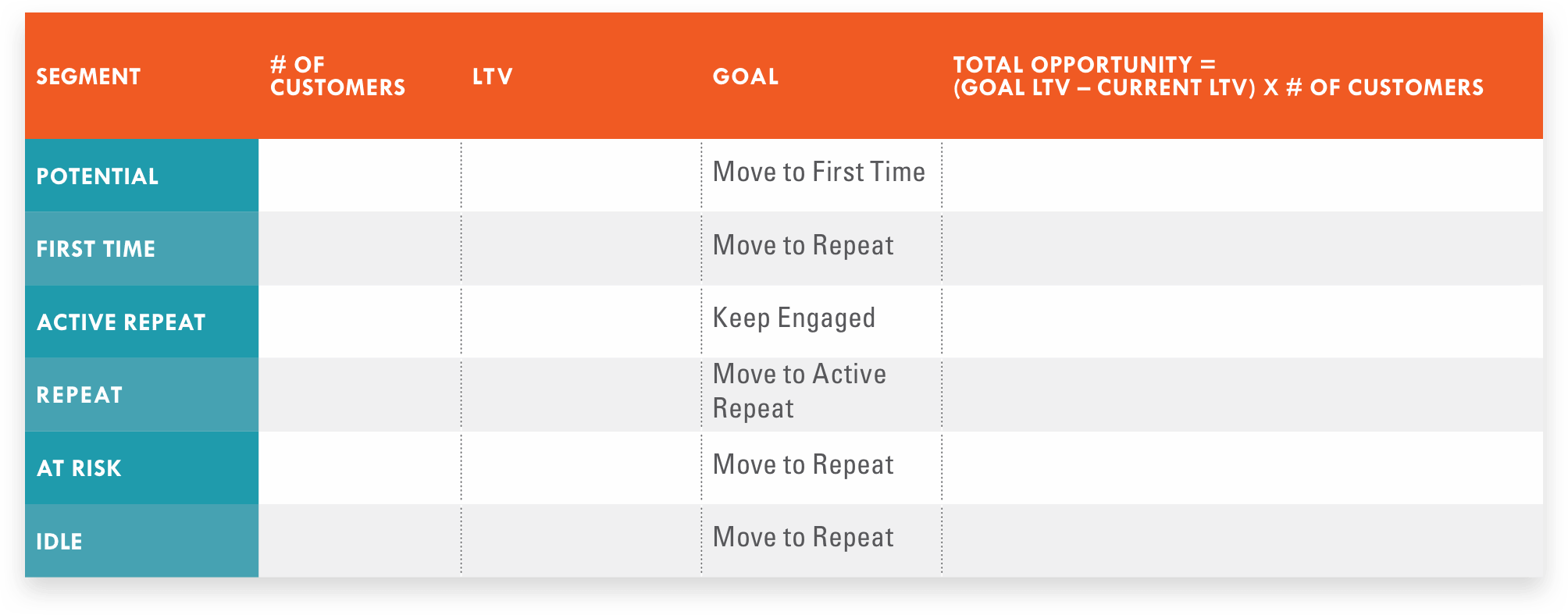
Next up in Lesson 9 of the Lead Nurturing Masterclass, we’ll cover in detail how to test and optimize your lead nurturing campaign.
.png?width=1920&height=553&name=cc-logo-color-horizontal%20(1).png)


